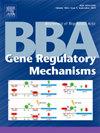导航肿瘤景观:VEGF, microrna和癌症治疗的未来
IF 2.6
3区 生物学
Q3 BIOCHEMISTRY & MOLECULAR BIOLOGY
Biochimica et Biophysica Acta-Gene Regulatory Mechanisms
Pub Date : 2025-05-03
DOI:10.1016/j.bbagrm.2025.195091
引用次数: 0
摘要
癌症的进展是一个多方面的过程,受肿瘤微环境(TME)内复杂相互作用的影响。这些动态的核心是血管内皮生长因子(VEGF)信号传导和microRNA (miRNA)调节,两者在肿瘤生长和血管生成中起着关键作用。VEGF对促进血管形成至关重要;然而,它的剪接变体VEGF165b作为一种抗血管生成因子,提出了一个挑战传统癌症治疗的悖论。同时,miRNAs通过靶向参与信号通路的各种mrna来调节基因表达,显著影响肿瘤行为。VEGF和mirna之间的相互作用为靶向治疗开辟了新的途径,旨在破坏支持肿瘤生长的网络。此外,利用VEGF剪接变体的独特特性的概念正在被探索,以开发新的治疗方法,增强抗血管生成作用,同时最大限度地减少副作用。了解这一点对于推进个性化治疗至关重要,可以有效地解决肿瘤适应性和耐药机制带来的挑战。本文章由计算机程序翻译,如有差异,请以英文原文为准。

Navigating the tumor landscape: VEGF, MicroRNAs, and the future of cancer treatment
Cancer progression is a multifaceted process influenced by complex interactions within the tumor microenvironment (TME). Central to these dynamics are Vascular Endothelial Growth Factor (VEGF) signalling and microRNA (miRNA) modulation, both of which play critical roles in tumor growth and angiogenesis. VEGF is essential for promoting blood vessel formation; however, its splice variant, VEGF165b, acts as an anti-angiogenic factor, presenting a paradox challenging conventional cancer therapies. Meanwhile, miRNAs regulate gene expression that significantly impacts tumor behaviour by targeting various mRNAs involved in signalling pathways. The interplay between VEGF and miRNAs opens new avenues for targeted therapies designed to disrupt the networks supporting tumor growth. Additionally, the concept of exploiting the unique properties of VEGF splice variants is being explored to develop novel treatments that enhance anti-angiogenic effects while minimizing side effects. Understanding this is crucial for advancing personalized therapies that can effectively address the challenges posed by tumor adaptability and resistance mechanisms.
求助全文
通过发布文献求助,成功后即可免费获取论文全文。
去求助
来源期刊
CiteScore
9.20
自引率
2.10%
发文量
63
审稿时长
44 days
期刊介绍:
BBA Gene Regulatory Mechanisms includes reports that describe novel insights into mechanisms of transcriptional, post-transcriptional and translational gene regulation. Special emphasis is placed on papers that identify epigenetic mechanisms of gene regulation, including chromatin, modification, and remodeling. This section also encompasses mechanistic studies of regulatory proteins and protein complexes; regulatory or mechanistic aspects of RNA processing; regulation of expression by small RNAs; genomic analysis of gene expression patterns; and modeling of gene regulatory pathways. Papers describing gene promoters, enhancers, silencers or other regulatory DNA regions must incorporate significant functions studies.

 求助内容:
求助内容: 应助结果提醒方式:
应助结果提醒方式:


